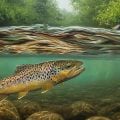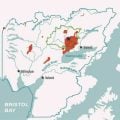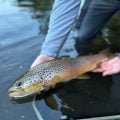“An Emerger By Any Other Name”

Anthony Naples photo
Question: “Looking at my assortment of flies collected through the years, I cannot tell which are emergers and which are dry flies. Is there a way to tell the difference?”
—Matt J
Answer: Funny you should ask, Matt, I mean that you should ask now—I’m just finishing up a new class on fishing emergers (and soft-hackles and wet flies) for a fly-fishing show next month in Utah. Good timing—I’ve got all the angles (or rather, all the angles I know) fresh in my mind.
Look, it’s no wonder you’re confused—the whole matter of emerger-flies is a tangle. Take nymphs, that is, nymph fly patterns. They’re nearly always tied on thick-wire hooks, and plainly designed to imitate, or at a minimum, suggest insects in their underwater forms (larvae, nymphs, pupae). Pretty straightforward. Even nutso attractor nymphs (the Gold Bead Prince Nymph, for example) have a somewhat real-nymph form and are easy enough to identify as nymphs.
Same goes for streamers—they’re supposed to specifically to broadly suggest little fish, and it’s fairly easy to see that the great majority of them do.
When you get to dry flies, though, you enter the problem—dries start blending with emerger-flies.
When you do get, finally, to emerger-flies, things really go haywire. Yes, emergers imitate specific creatures too, but the patterns are all over the place.
The dry fly/emerger confusion is messy enough that, undoubtedly (well, I at least have no doubt), a good many patterns will remain forever in debate: are they dries or emergers? Who really knows?
The whole big group of patterns we call soft-hackled flies—are they emergers? They imitate insects emerging or about to emerge from shucks. Traditional wet fly patterns as they’re fished today, to imitate insects inches under water that have just shed their shucks—are they emergers?
Even true nymph patterns, such as the Gold Ribbed Hare’s Ear and Fox’s Poopah—if they’re fished swinging across the current, imitating underwater nymphs and pupae heading up to hatch—are they emergers?
I’m getting dizzy. You decide.
As must now be plain, categorizing flies that are or might be emergers takes you into a fuzzy realm. But let me shave off most of that fuzz. (Slick metaphore, yes? No? Okay, agreed: no.)
Let’s begin with this: pick up one of your flies in question, Matt, really look it over, and then answer these questions:
1. Is there a tipoff?
Usually that will be the presence, or lack, of something suggesting an insect shuck projecting off the back end of the hook. Tails: probably not an emerger. Shuck: probably an emerger. The presence of something appearing as partially freed wings: emerger. The rear half of the fly tied with heavy or absorbent materials (wire, rabbit fur, hen-back hackle fibers) while the front half is all buoyant stuff: emerger. And then there’s the obvious: the name. The Partridge Caddis Emerger, Morris Emerger, CDC Emerging Dun—what kind of flies do you suppose these are?
2. Does the fly float fully atop the water, down on it, or half submerged in it?
If it stands high on the water, it’s almost certainly a dry fly (the Stimulator, the Royal Wulff, etc.). If it lies body-down on the water, toss up. If it hangs partly below the surface it’s almost surely an emerger fly. If it sinks entirely, might be a tough call.
3. Can you find the fly in a catalog or on-line and run down info on it?
That question begs this one: Do you want to chase down info on it? I usually don’t, but will if a fly that snuck into one of my boxes really befuddles me.
4. What do you think the trout will take it to be?
This is really the big one, because if you see the fly as an emerger and fish it as one, then an emerger-fly it is—especially if the trout take it while taking real emerging insects.
Trout often take our flies as things our flies weren’t designed to suggest. A brown trout takes a Compara-dun, a mayfly imitation, thinking it’s a hatching caddis. A rainbow takes a Peeking Caddis nymph, drifting along a streambed, as a nymph of the Golden Stonefly. So on, so on.
Happens all the time. Make this principal work for you by keeping an open mind about what flies can represent.
Considering this last point in particular, perhaps it’s not as important as you might expect, Matt, to recognize which of your flies are qualify as emergers. More important: simply select your flies for based on common sense. Maybe even more important than that: observation. Substitute a wide view, a little extra looking and considering, for a lack of technical knowledge and you’ll probably come out ahead in the end—that is, you’ll catch more fish. It’d be ideal to have both: the freethinking focus and the knowledge. Still, having the most valuable of the two right at hand takes some of the heat off, yes?
So whether or not a fly qualifies as an emerger can depend on its name, or its design, or on how it lies on or in or just under the water, or on how and where and when you fish it, or on whom you ask. Pretty vague, right?
So here’s a definition of an emerger, Matt, loose as it is, that if nothing else may help you see that your confusion is entirely justified: An emerger fly is any fly that probably, or at least possibly, imitates an insect at some stage of wriggling out of its shuck, some stage of its hatching—or, perhaps, even an insect just prior to its hatching or just after.
We fly fishers hate fishing muddy water, but for some reason love to stir up the mud of our terminology. And defining what is and what isn’t an emerger fly pattern is about the worst of it—real mud wrestling. (Remember that, it was big in the 80s? Oh, you were trying to forget it? Sorry.)
Still, by now, Matt, it must be clear that trout are quite open minded about this whole matter. I believe we’d all be wise to follow their example.











